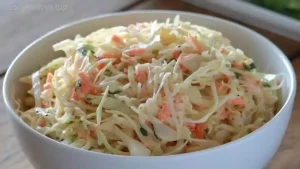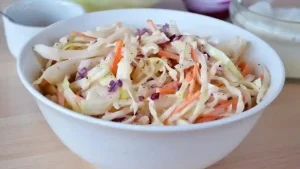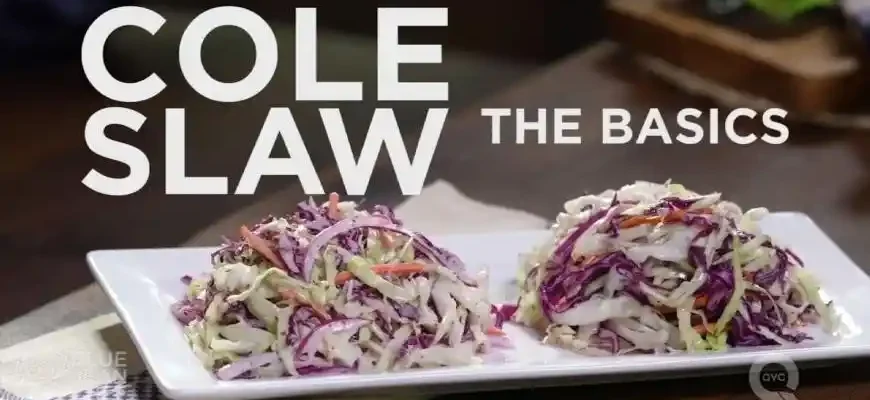Coleslaw. It’s one of those dishes that has graced picnics, barbecues, and family gatherings for generations. It’s simple, versatile, and loved by many. But behind its humble appearance lies a fascinating blend of flavors, textures, and histories. Making a great coleslaw requires more than just mixing cabbage with mayonnaise—there’s an art to getting it right. Whether you’re a seasoned chef or someone who’s just starting out in the kitchen, let’s break down everything you need to know to make the perfect coleslaw.
What Exactly Is Coleslaw?
At its core, coleslaw is a salad typically made from finely shredded raw cabbage, dressed most commonly in a mayonnaise-based dressing. But don’t be fooled—there’s a lot more to it than just that. Variations abound depending on region, culture, and individual preferences. Some recipes swap out the mayo for a tangy vinegar-based dressing, and others add extra ingredients like carrots, onions, or even fruit. The possibilities are endless!
The word “coleslaw” itself comes from the Dutch word koolsla, meaning “cabbage salad.” But the idea of cabbage-based salads has been around for centuries, showing up in ancient Roman culinary traditions.
The Basic Recipe
Before we dive into the nuances and variations, let’s start with the classic coleslaw recipe—the foundation on which everything else is built.
Ingredients:
- 1 medium green cabbage (about 1-2 pounds)
- 1 large carrot (optional, but adds a nice color and sweetness)
- 1/2 cup mayonnaise (look for a high-quality, full-fat mayo for the best texture)
- 1 tablespoon apple cider vinegar (this helps balance the richness of the mayo)
- 1 tablespoon Dijon mustard (optional for a slight tang)
- 1 teaspoon sugar (to taste, depending on how sweet you like it)
- Salt and pepper (to taste)
Instructions:
- Prepare the Vegetables:
- Slice the cabbage in half, remove the tough core, and then finely shred it. A mandoline slicer or food processor makes this process much easier and more uniform. You want your cabbage pieces to be thin but not paper-thin.
- Grate the carrot (if using). It adds a bit of color and crunch, balancing the cabbage’s texture.
- Make the Dressing:
- In a large bowl, whisk together the mayonnaise, vinegar, mustard, sugar, salt, and pepper. Taste and adjust as necessary. Some like it sweeter, others prefer a more vinegar-forward profile.
- Combine:

- Toss the cabbage and carrot with the dressing. Make sure every piece is evenly coated. If you have the time, let it sit for about 30 minutes to allow the flavors to meld. Coleslaw can be made a day ahead, which actually enhances the flavors.
- Serve:
- Serve chilled, garnished with a sprinkle of fresh herbs like parsley or dill if desired.
Variations on the Classic Coleslaw
Now that you have the basic recipe down, let’s talk about variations. Depending on your taste, you can tweak and adjust coleslaw to suit almost any palate or meal.
- Vinegar-Based Coleslaw:
Some people prefer a tangy, less creamy version of coleslaw. In this case, swap the mayonnaise for a combination of vinegar (apple cider or white), a little bit of sugar, and a touch of oil. It’s a much lighter, zesty version that pairs especially well with BBQ. - Southern-Style Coleslaw:
This is the version many associate with fried chicken and pulled pork. It’s usually very creamy and sweet, with the addition of ingredients like buttermilk or sour cream, and often a dash of celery seed or mustard for added flavor. - Asian-Inspired Coleslaw:
Add a little sesame oil, rice vinegar, and a touch of soy sauce for a completely different flavor profile. Toss in some cilantro, green onions, and perhaps a sprinkle of toasted sesame seeds, and you’ve got yourself a unique slaw that pairs beautifully with grilled meats or as a topping for tacos. - Coleslaw with Fruit:
Apples, pineapples, or even oranges can add a refreshing, sweet element. The acidity from the fruit can help cut through the richness of the dressing and balance the flavors nicely.
Nutritional Considerations
Now, let’s talk about the elephant in the room: colesi is often seen as an indulgent side dish because of its creamy dressing. But is it actually that bad for you? Well, like most things, it depends on how you make it.
- Calories & Fat: The standard coleslaw made with mayo can be high in calories and fat, especially saturated fat. If you’re concerned about your waistline or your cholesterol, you can use a low-fat or Greek yogurt-based dressing as a healthier alternative.
- Fiber & Vitamins: On the flip side, coleslaw is loaded with cabbage, which is rich in fiber, vitamin C, and antioxidants. If you use a mix of cabbage types, such as red and green, you can further boost the nutritional value.
- Sodium: One important thing to watch is the sodium content. If you’re using pre-packaged mayo or dressing, it may contain quite a bit of salt. To control the salt, try making your own dressing or using low-sodium options.
Common Mistakes When Making Coleslaw (and How to Avoid Them)
- Overdressing It:
The cabbage should be coated but not swimming in dressing. If you use too much dressing, it can overwhelm the flavor of the cabbage. Start small and add more if necessary. - Not Letting It Rest:
If you serve coleslaw immediately, it might taste okay, but the flavors will really shine if you give it time to sit in the fridge for at least 30 minutes—or even better, overnight. - Using Old or Wilted Cabbage:
Fresh cabbage makes the difference between a crunchy, crisp slaw and a soggy mess. Make sure you’re working with cabbage that is firm and vibrant. - Not Tasting as You Go:
Every cabbage and carrot is different. Don’t be afraid to adjust the dressing to suit your taste. Add a little more sugar if you want it sweeter, or more vinegar if you prefer it tangier.

The Coleslaw Debate: Creamy vs. Vinegar
One question that seems to split people down the middle is: Should coleslaw be creamy or tangy?
- Creamy coleslaw is rich and smooth, often sweet, and pairs wonderfully with hearty, smoky dishes like BBQ and fried chicken. It’s the classic American version.
- Vinegar-based coleslaw, on the other hand, is light, refreshing, and much tangier. It’s often preferred in places where BBQ is served with a bit more heat or spice, like in the southern U.S. or even certain parts of Asia.
Ultimately, the choice is yours—and that’s what makes coleslaw so wonderfully adaptable.
Global Views on Coleslaw: What People Are Saying
To get a broader sense of how coleslaw is perceived around the world, here are a few opinions from people of different ages, genders, and countries:
- Marina (30s, USA):
“Coleslaw is a must at every BBQ I attend. I make it creamy, with a hint of sweetness. It’s perfect next to grilled meats and burgers.” - Carlos (50s, Spain):
“I prefer the tangy, vinegar-based version. We serve it with fish in Spain, and it adds a refreshing touch to any seafood meal.” - Yumi (40s, Japan):
“I love the Asian-style coleslaw with sesame oil and soy sauce. It’s a great side dish for grilled chicken or even as a topping for sushi.” - Thabo (20s, South Africa):
“In South Africa, we make a simple coleslaw with carrots and cabbage, dressed with mayo and vinegar. It’s often served alongside boerewors or steak.” - Rita (60s, UK):
“I always go for the classic creamy coleslaw, but I sometimes add a little bit of Dijon mustard to give it an extra kick. It’s a nice contrast to all the hearty meals we have.”
Conclusion: Coleslaw—A Dish for Everyone
There you have it. Whether you go creamy, tangy, or try something completely different, coleslaw is a versatile dish that can suit just about any taste. It’s easy to make, adaptable, and can be enjoyed in countless ways. So, next time you’re looking for a side dish, why not give coleslaw a try? Just remember to keep your cabbage fresh, taste your dressing, and don’t be afraid to experiment. After all, in the world of coleslaw, there are no wrong answers—just different flavors to enjoy!
Happy cooking!









